Zoom F6 Portable 32-Bit Float Point Recorder – Ultimate Portable Interface
Zoom F6 is the latest, strongest and best (spec wise) portable recorder made by Zoom, and comes with a price tag of 700 USD. Today we will explore it and its abilities, and we will also explore how it compares to Zoom H5(280 USD), Zoom H2n(200 USD), Lotoo Paw 1(500 USD), and we will also be exploring pairings between Zoom F6 and Rode NTG-2 Shotgun Microphone and Rode NTG-3B Shotgun Microphone.
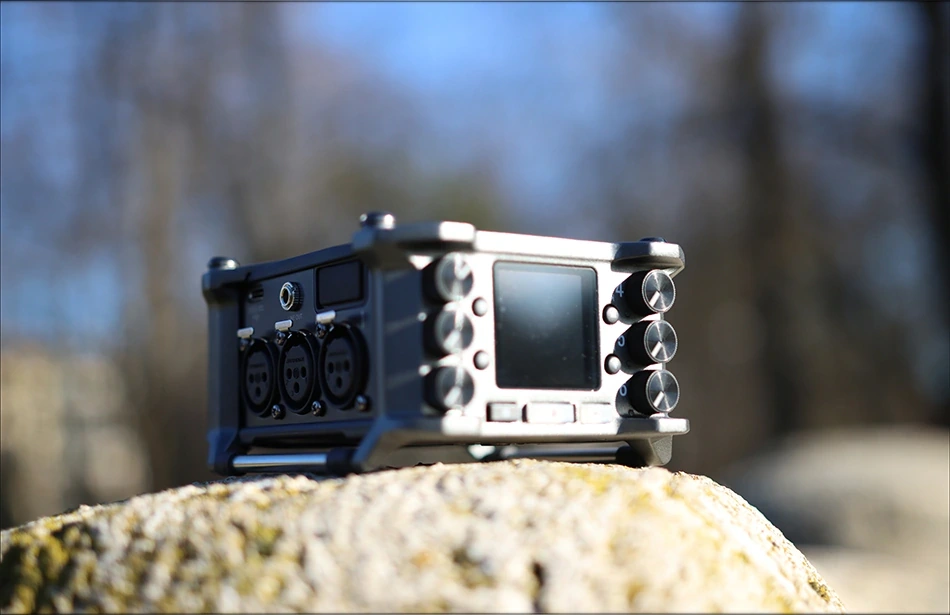
Introduction
Zoom is a big name for anyone who ever had to record something, literally anything. They generally make the best recorders if you need to be on the go, and portable recorders usually tend to have much better quality than most interfaces, although if you’re working a lot on a computer you can even use most Zoom products as digital USB interfaces. Zoom is generally really reliable and most of their products are used beyond death, with movie producers using older zoom recorders even to date, and even in big budget movies. This is the same for game studios and music recording, zoom products being employed literally everywhere people need to record audio.
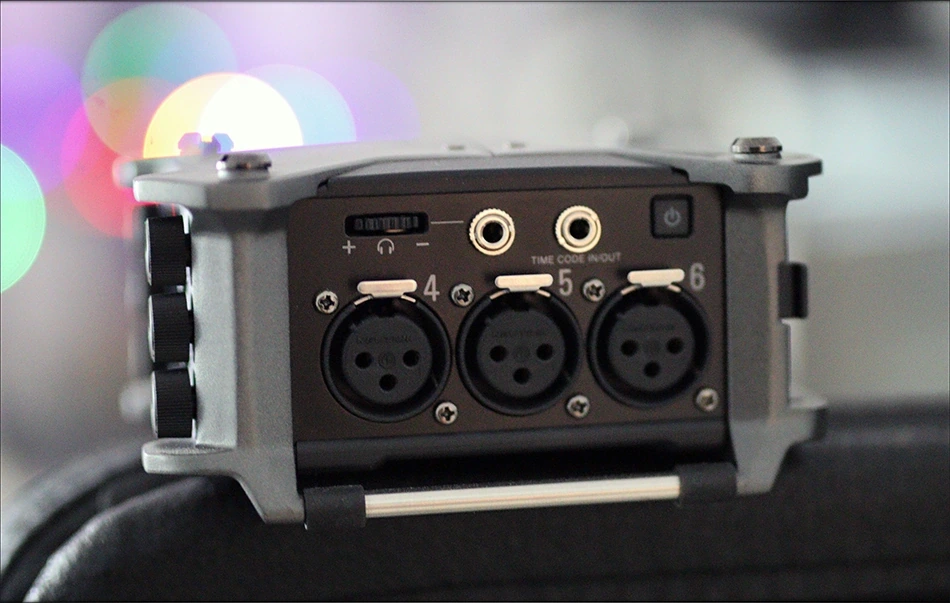
It should be noted that I have absolutely no affiliation with Zoom. I’d like to thank Zoom for providing the sample for this review. This review reflects my personal experience with the Zoom F6 Portable Recorder. Every opinion expressed is mine and I stand by it, the purpose of this review is to help those interested in Zoom F6 find their next music companion.
Product Link
You can grab one from www.amazon.com here: https://amzn.to/3AJcVgS
If you’re in the UK, you can grab one from www.amazon.co.uk here: https://amzn.to/3GeKpVs
And if you’re from Europe, you can grab one from www.amazon.de here: https://amzn.to/3rduT7S
Packaging
First things first, let’s get the packaging out of the way:
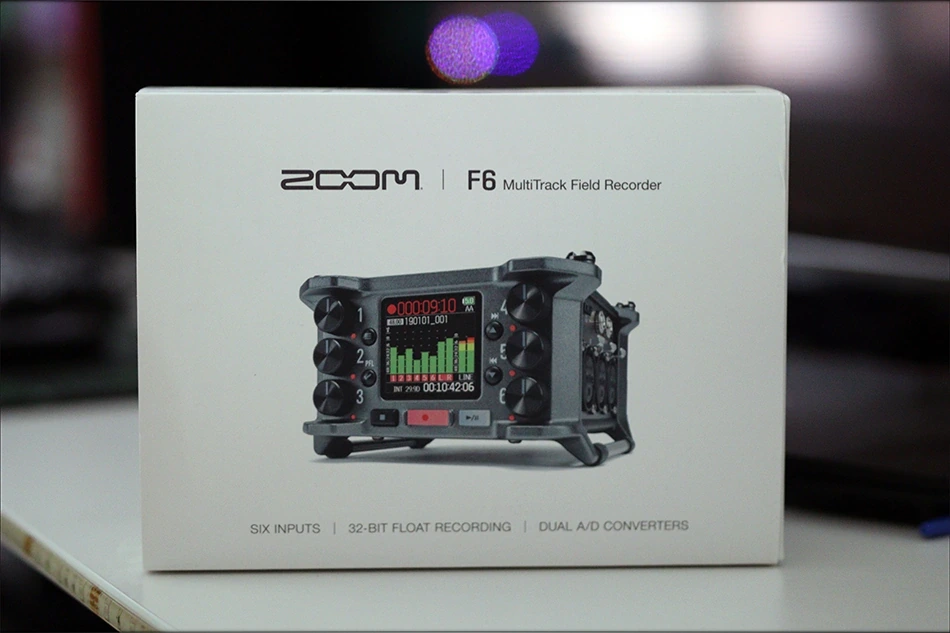
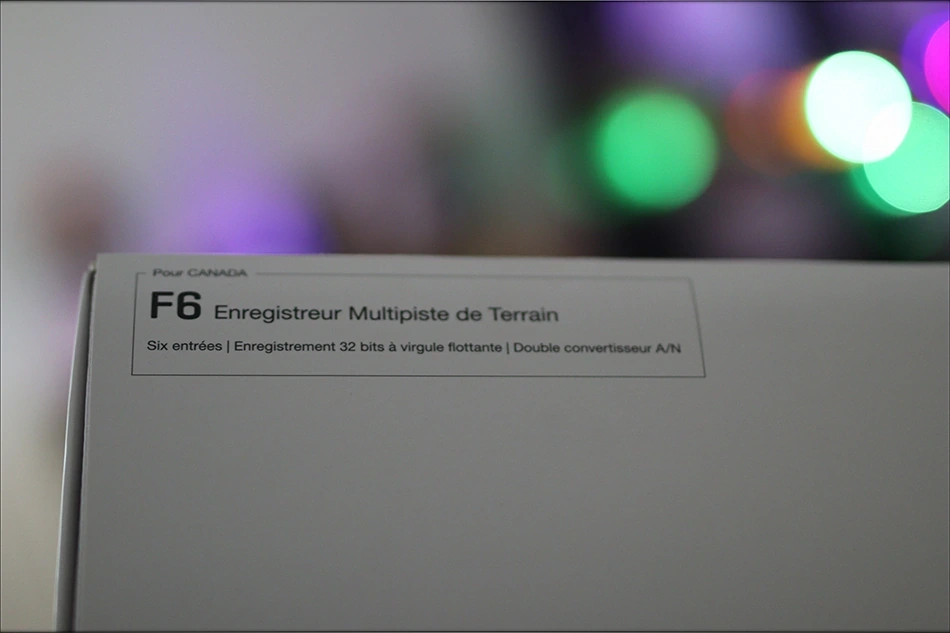
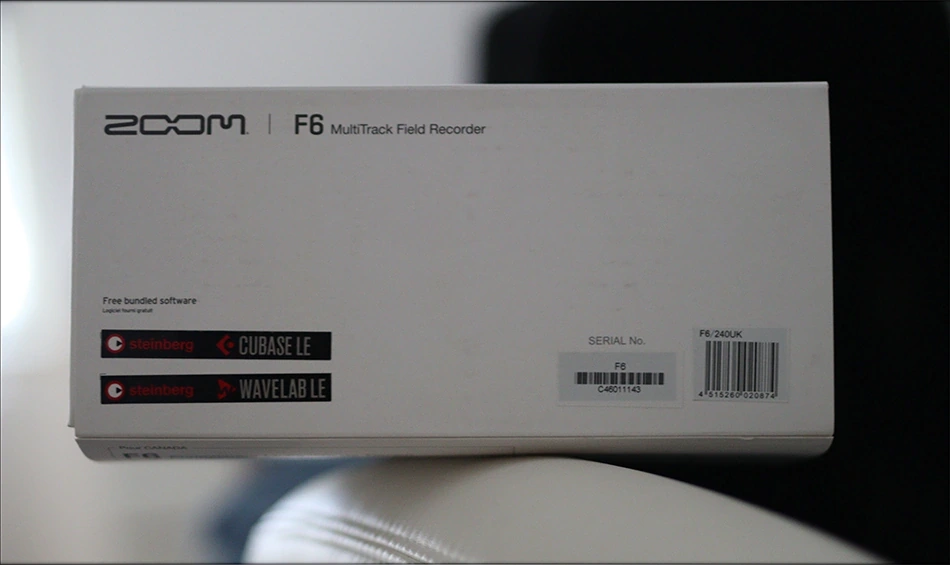
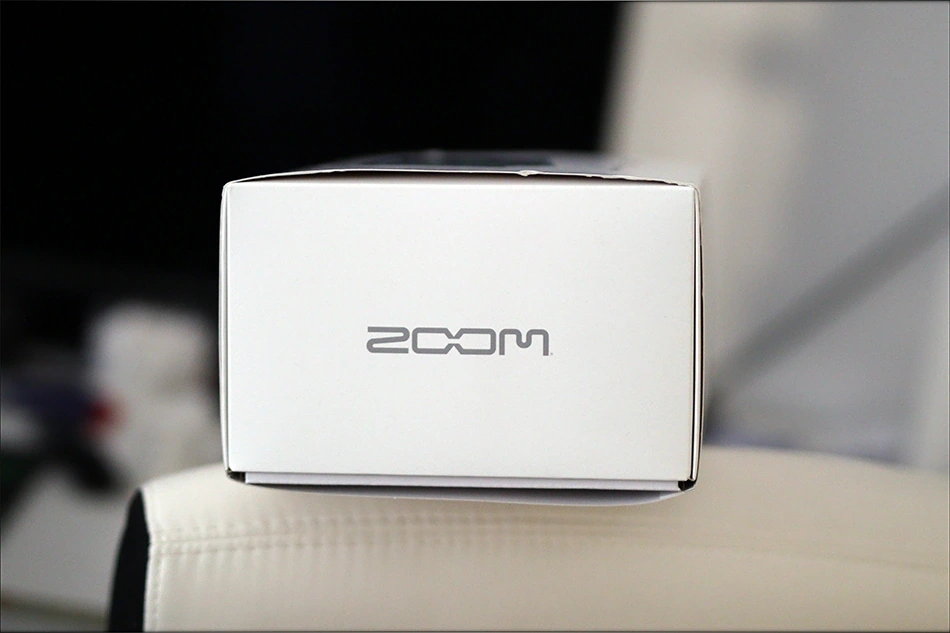
Zoom F6 comes in a large package, but if you’re looking for many extras, there really aren’t many. Most zoom products come with a carrying case, but given the shape and size of Zoom F6, you’ll mostly have to rely on third party creative cases for this one. The package of F6 includes:
- The field recorder itself
- A camera mount adapter, to hold it on your camera
- 4 AA batteries (non rechargeable)
- Quick Start Guide
- Cubase LE download code
- Wavelab LE download code
Build Quality/Aesthetics/Functionality
Zoom F6 is very different from the original Zoom H5 I’ve been using for years now, and they really improved on the reliability and overall build quality parts with the new one. We have a nice color display this time around, with VU Meters, and 6 separate volume wheels for controlling the volume of Zoom F6’s inputs. This is really useful for those who use different microphones at the same time.
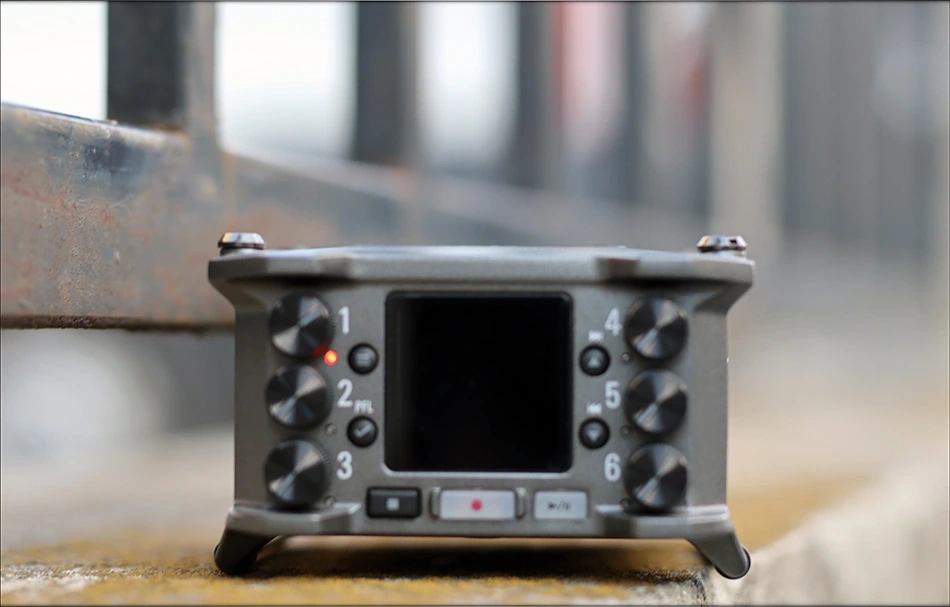
Zoom designed this unit to be as robust as possible, with a full metallic body, and metallic latches for all of its XLR inputs. We have 32bit Float processing, and dual AD or Analogue to Digital converters inside F6, and this applies to all of its 6 XLR inputs. The amount of dynamic range that F6 is capable of processing goes from whispers all the way to metal concerts and rocket launches, the 32-bit float processing meaning that it should never run out of dynamic range and should never distort. This does not eliminate the need for processing your sound, but it allows you to recover information even if the difference in loudness was extreme at the moment of recording.
Since F6 is a field recorder, this means that it will have to record sound and music in very inconvenient situations, and that it is prepped to go with you wherever you need it. To comply with the most hardcore recording situations (for example recording bird sounds in the forest, recording waterfalls, and other sound effects necessary for movie and game design), F6 is designed with three different power supply options, including 4 X AA batteries (works with rechargeable batteries), Sony L-Series batteries, and it also works with an AD-17 AC Adapter. The Sony L-Series batteries are not included in the package, but if you decided to invest in F6, you probably know what you’re doing already, and don’t mind spending a bit more on an external battery. I have been using F6 mostly with the 4 X AA battery option, and I’ve done this with rechargeable batteries, time in which I found out that Eneloop Pro batteries from Phillips have the best overall battery life.
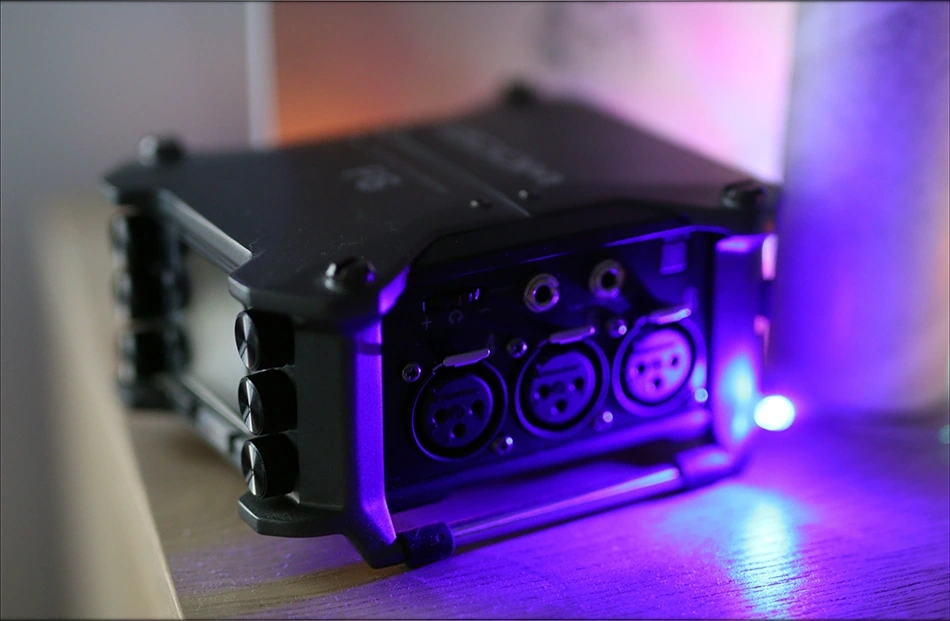
F6 also features Advanced Look-Ahead Hybrid Limiters, and it has switchable +4dB inputs for mic/line. We have the highest quality of preamplifier embedded in F6, with up to 75dB gain, and -127dBu EIN. This, once again, works for all 6 XLR inputs, and each input has two tracks, so you can do 6-Channels and 14-track recording at the same time, with F6. We have a monitoring jack, 3.5mm Stereo single ended / unbalanced jack, and the headphone output is actually an audiophile-grade 100mW volume control.
The SD slot can accommodate SD cards as high as 512GB, and since the data rate isn’t extremely high, F6 recording only audio, you won’t need to purchase special cards for it either.
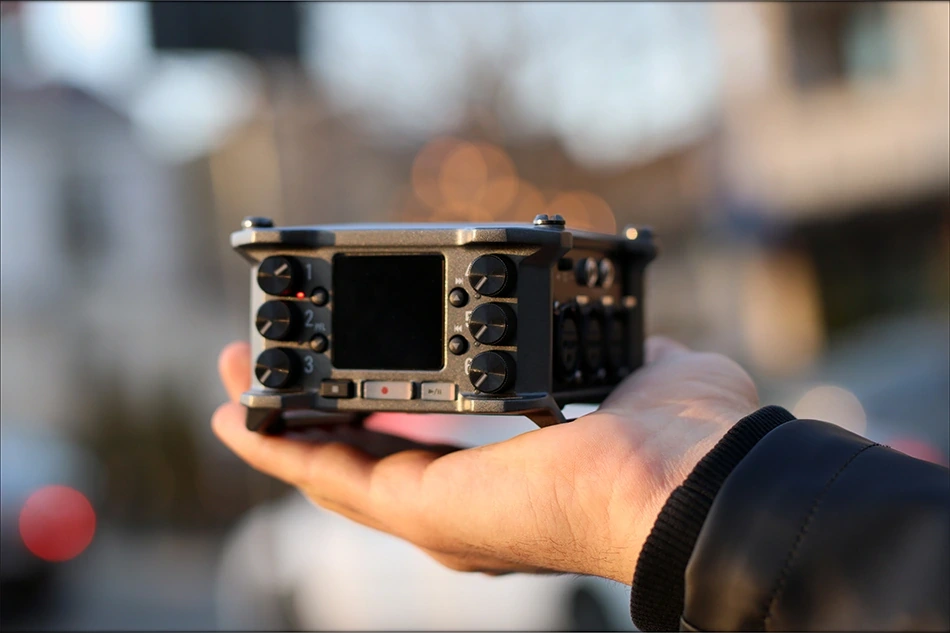
You can even use Zoom F6 as an audio interface to record music to your computer, a situation in which it works up to 48kHz, and it can do both recording to the microSD card, and recording to your PC, at the same time. There’s a Zoom F Control App for iOS that allows wireless remote controlling, file renaming and metadata entry, but as far as I know, there is no Android variant available out there yet. Zoom features an algorithm named Zoom Automix which helps you with volume leveling and lowers the need to always change the volume, and will automatically adjust the volume of your mix to reduce the ambient sound.
For professional filmmakers, Zoom designed F-Control FRC-8 which has 60mm faders and controls for trim, pan and track arming, although this is a hardware component sold separately. Since VR and 3D content has been making a huge rise for everyone, Zoom has an Ambisonics mode, and it offers A-to-B decoding and balanced and linking, allowing for VR, and AR sonic capture for 360 degrees audio.
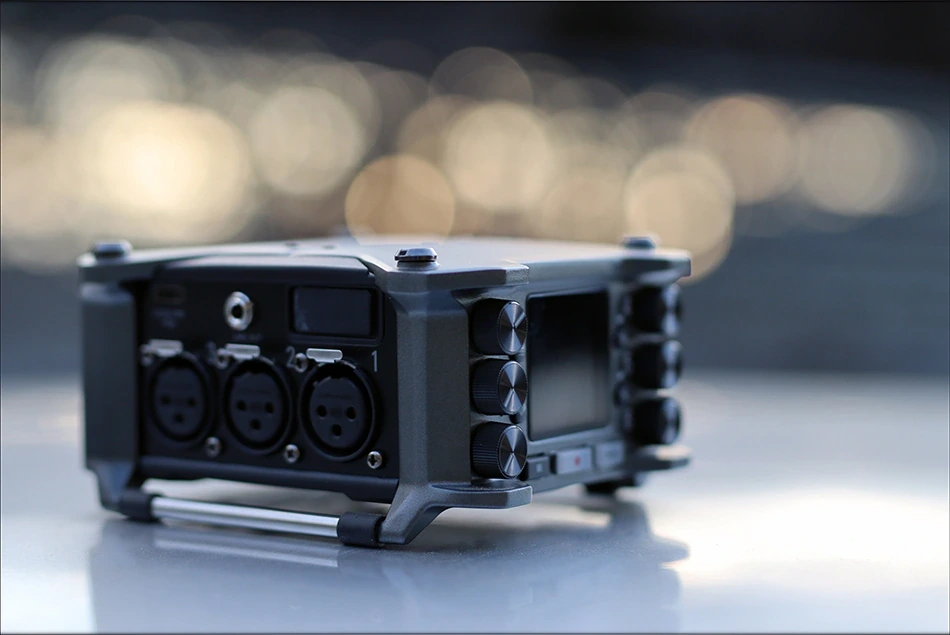
Each one of the six XLR inputs has Neutrick XLR Connectors with locks on them, and individual volume knobs. You can see the volume as you adjust it on the display, and it is adjustable by 1dB. The Zoom F6 also has record, stop, pause and play controls on the face, and a 1.54″ LCD monitor that’s bright and will easily be visible while in the field.
Recording usage & Experience
If you never used a recorder before, setting up F6 will take about 5 minutes until you configure everything and you’re ready to go. I do not really recommend it for beginners, since it is a pretty professional unit, but it will offer the absolutely best sonic quality and performance from all portable recorders, so it will be useful. This is the kind of recorder used at Hollywood for big movies, so don’t be shy, even if it looks rather small and pocket friendly.
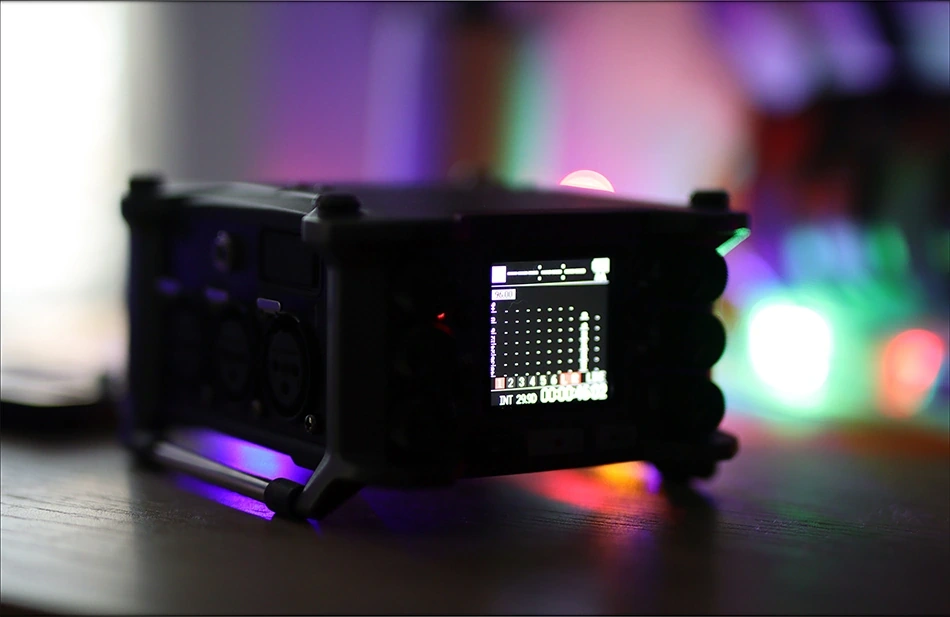
I have tried using Zoom F6 with multiple microphones, most of them Shotgun type, and it features a 3kOhm input impedance, with options for phantom power of 24 Volts or 48 Volts. This works much better than you can imagine, all microphones sound great, and my favorite part is that using the phantom power from F6 sounds considerably better than using batteries on microphones that allow it, like the Rode series of shotgun mics.
Zoom F6 makes everything really easy as it has volume meters with peak indicators, so you know when your mic is set too loud. I would personally suggest setting the sound in such a way that the volume on the monitor never shows peaks above -6dB and I would suggest increasing the volume in post, using a simple audio editor app. It is really easy to match video and F6’s audio if you clap right after you press record, this being the main way people have been syncing video with audio.
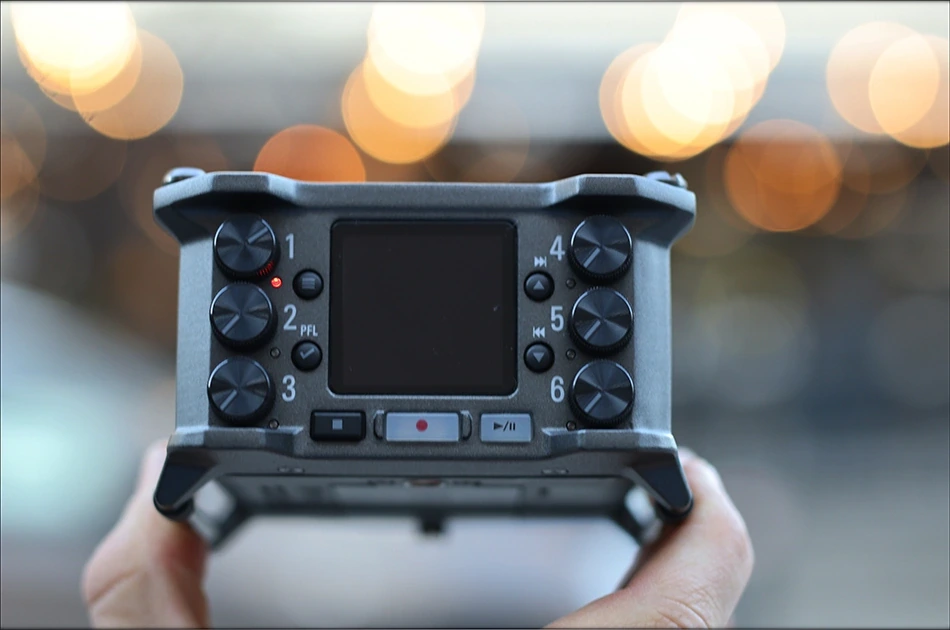
F6 is really rugged, has some edges, and does not require a lot of special protection, but will scratch rather easily and my unit already has some usage signs, even though I mainly used it indoors and the only times where it could get scratched have been when it was in a backpack next to IEMs and headphones, for the B-Rolls and photo shots.
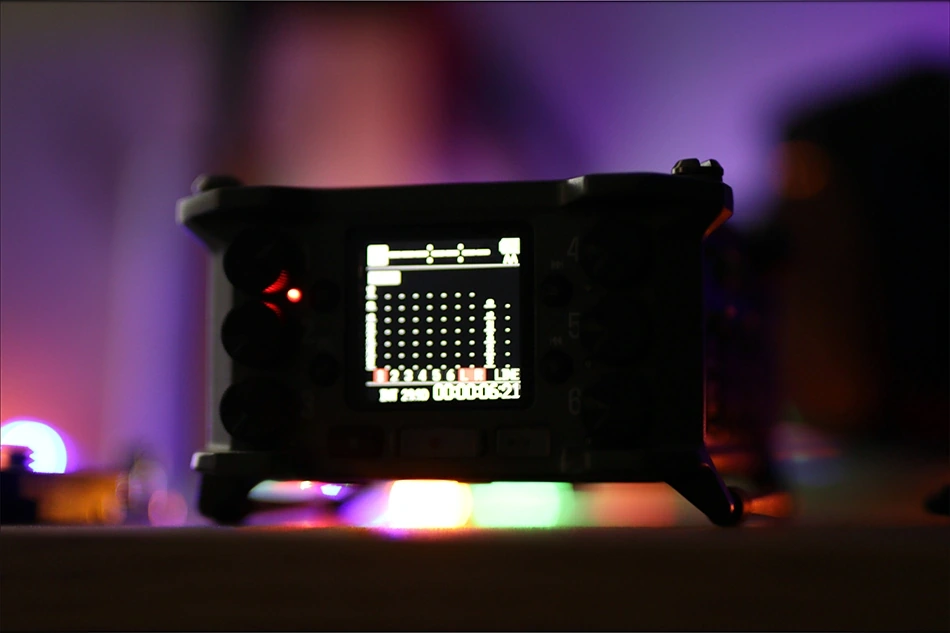
I have been powering the Rode NTG-2 Microphone from Zoom F6 and Zoom H5n. It requires phantom power, so here the quality of the recoder is quite important. H5n struggles with NTG-2, which requires quite a bit of power, and you can hear some distortion when you increase the volume on H5n, and you generally can’t get it loud enough without distorting, and increasing the volume in post results in far more distortion than F6, which is completely silent, and provides a much cleaner, deeper and distortion-free sound.
The same happens when I try to power Rode NTG-3B, which also requires phantom power, and where the quality of the recorder also shines through, but this one is different. NTG-3B requires very little power and will happily work with both Zoom H5 and Zoom F6, but the sound is quite different. NTG-3B picks up noise floors really easily and even at lower volumes, Zoom H5, as well as other more budget oriented recorders will have a somewhat high noise floor with NTG-3B, which sounds like a constant hissing and background noise that’s happening. This does not happen with Zoom F6, and it is able to not only have enough power for Rode NTG-2, which eats power like candy, but also have enough control and a low enough noise floor for Rode NTG-3B.
Sound Quality
The two major parts of F6’s sonic performance when recording are the microphone preamplifiers, and the ADC or Analogue to Digital converters that help convert the sound recorded to digital information that our computers can read and process. F6 features top of the line, ultra high-end microphone preamplifiers, as well as ADC or analogue to digital converters, and it is one of the best sounding microphone recorders / interface / portable recorders that money can buy in 2022.
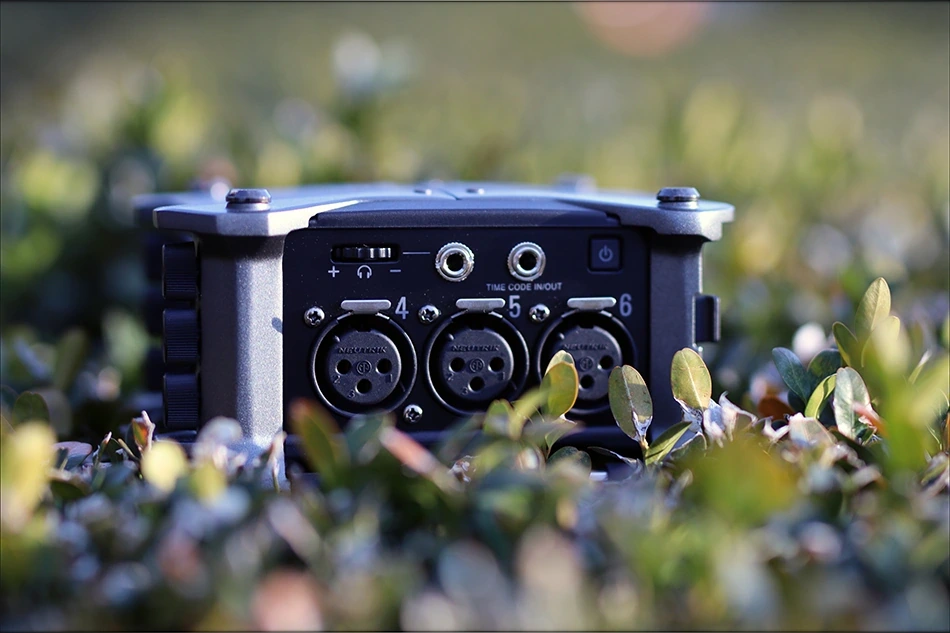
The overall sound of F6 can be described as really clean, clear, with no colorations, but extremely low distortion. It is possible to tell apart the sound recorded by F6 and H5, as well as other recorders, as F6 has a much better overall clarity and detail level, with much less background noise, microphone hissing and overall distortions. If you’ve been following my Audiophile-Heaven Youtube Channel, I tend to have some dynamic variation in my videos, where sometimes I would be quite quiet, and other times I would talk much louder, and this would show as pretty bad clipping on H5 as well as H2n, and other recorders too, Zoom F6 being the first recorder that shows absolutely no clipping or stress when the dynamic is quite high.
Zoom F6 is great for recording music, even live concerts as well, and you can mic multiple singers, as well as instruments, thanks to its 6 XLR inputs, plus the sound is always really clean, clear and crisp with no background noise. Comparing just the sonics with Zoom H5, F6 has much better impact, and H5 tends to sound somewhat loose and wooly, with much more background noise. F6 is really noise and hiss free, and tends to have much lower distortion at high volumes.
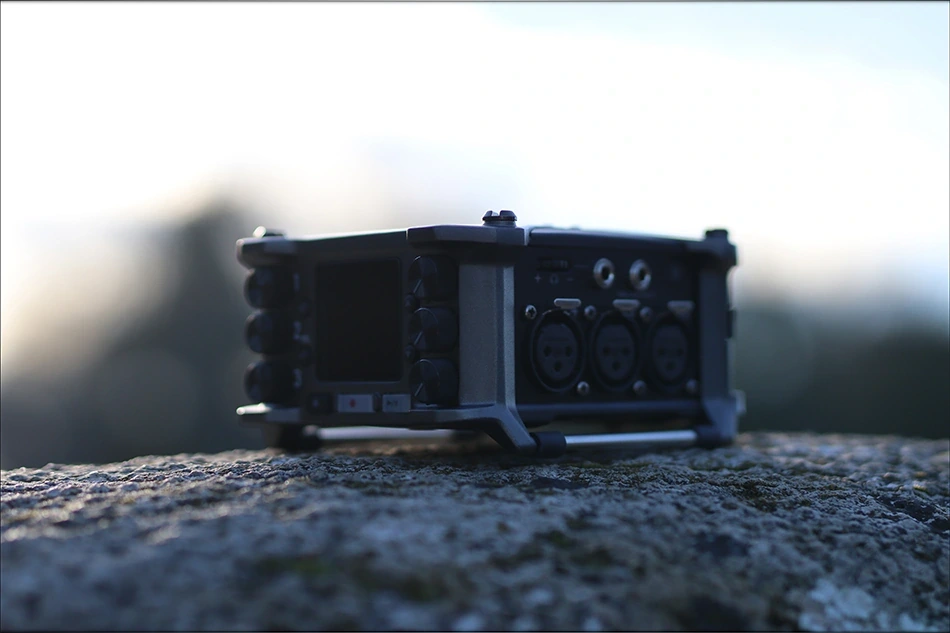
F6 has a really good quality for sound effects as well, and if you’ve been following my works, you probably heard about Seventh Heart Studios and our upcoming game Eternal Hour. I have used Zoom F6 to record some sound effects for Eternal Hour, and the quality is really good, you can use a shotgun mic to isolate a specific sound, for example a bird call, or a car honk, or you can use a dynamic microphone to record voice, and provide voice acting for a commercial project. I will be one of the voice actors in Eternal Hour too, and will definitely be using zoom F6 for recording my voice, although I have not yet decided which side character I will be playing. Since I’m the Director and the Programmer too, I don’t want to take the spotlight from actual professional voice actors who are much better at VA and Voiceover work.
With F6 you get a really clean representation of sound all across the frequency range. This makes it perfect for recording both voice and instruments, where most recorders tend to have some roll-off in either the treble or the bass. Usually, the microphone attached to a recorder is more of a limiting factor than the recorder, and the recorder mainly dictates the dynamic, clarity and detail of the recording rather than the depth in the lows or extension in the highs. This being said, doing side by side comparisons from videos I filmed using both I can say for sure that F6 is the top of all the recorders I used to date, and even using the same microphone with all of them, the sound will still be highly different between recorders, just like it changes when using different AMPs, DAPs and DACs for listening to music.
Comparisons
To start the comparisons part of today’s review, I want to highlight a few videos with audio recorded using Zoom F6. Please check this, this and this video to understand how F6 sounds like. You can use this to compare the sound quality between recorders. I will also be making a dedicated video where I highlight the differences in audio between all the recorders I’ve used throughout time, to help you better understand how they sound.
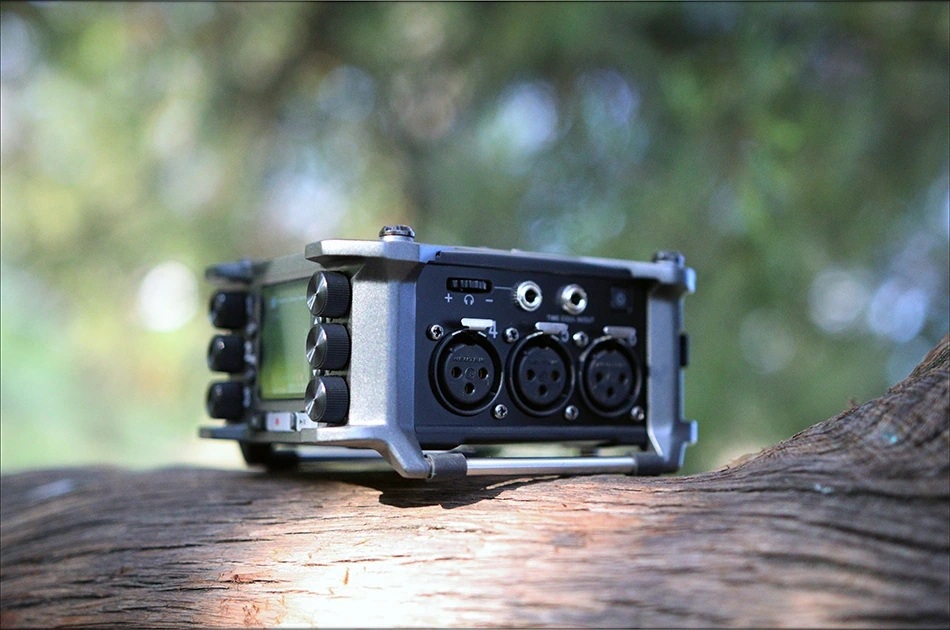
Zoom F6 vs Zoom H5 (700 USD vs 280 USD) – You can check a video recorded with Zoom H5 here, and one with Zoom F6 here. It should highlight the differences between F6 and H5 fairly well. The usability of the two is different, I never seen H5 as a rugged type of device, and always had to pay tons of attention to not breaking it. It is also made of plastic and feels less like a high-end outdoors interface, but you can see it being used by Disney productions along with youtubers with millions of views for artistic projects, so it is not much less of a recorder, just a different option. F6 sounds like a huge upgrade over the H5, with a much much better dynamic, less distortion at both high and low levels, with much more clarity, better textures to voice (more natural texture, H5 sounds smoother, but lacks the proper timbre to sound natural), and F6 sounds considerably more controlled too, especially when you’re using a better microphone that shows the differences. I am, of course, talking about using the same external mic, because H5 has an embedded XY mic, which for about half of the price of F6 is a really nice bonus. We’re talking about a device with which you can already start recording in Zoom H5, while with F6, you invest about 700 USD in F6, and you need to pay at least 400-600 USD more on a high quality microphone to justify your purchase. The XY mic of H5 is perfect for sound effects as well, plus it is more portable than having F6 + a cable + a microphone, but the quality is better on F6. You will have to adjust to the scope of your project, and decide on whether you can carry F6 and want a better sound, or if you can settle for H5 and don’t need to invest more in an interface.
Zoom F6 vs Zoom H2n (700 USD vs 200 USD) – Please check out this video with the audio recorded on H2n here. H2n is a mini recorder with no XLR input, and has multiple microphones, in both XY pairs, and a MS setting. Using H2 feels antiquated, it has a mini USB interface, compared to the Type-C interface of F6, and H2n is perfect for someone who’s just starting with audio and needs a really entry-level solution for their audio. It can be great for a small band trying to record a demo, or if you’re doing a small artistic project, but you will hear its limitations very quickly. Just like how Zoom H5’s XY microphone takes in more noise than a dedicated shotgun mic, it also takes Echo, and with XY mics, you hear the room you’re recording in. This is really nice if you go outdoors and need to record sound effects, especially if you want them to be stereo, but it is really not a good approach for voice. The MS option of H2n sounds better for voice, but H5 sounds much more clear, more dynamic, more detailed and has less background noise, plus less distortions than using H2n, so I upgraded from H2n to H5 in the past, even though it added some more echo to my recordings. Since H2n cannot be used with external microphones, I want to mention that the headphone output has a lot of noise and hissing, and you cannot use it as a direct interface to input microphone to your PC and play through the result to do Karaoke, as I tried doing that and the result is quite noisy. At the end of the day, H2n has a really clean and clear sound if you’re recording on a microSD card, and if you can take advantage of its XY microphone or MS microphone, but if you can afford to invest, Zoom H5 is a huge improvement, and Zoom F6 + a proper microphone is on another planet entirely. F6 has considerably better overall dynamic, better details, better timbre, more resolution, less distortions, less background noise, but it also costs considerably more, being the tool of a professional, where H2n is a perfect tool for a beginner, as I was when I started doing Youtube.
Zoom F6 vs Lotoo Paw 1 (700 USD vs 500 USD) – No video is available on Paw s1 right now, but I am working on one, you should see it on my Youtube Channel once I manage to finish one. Paw S1 is an XY microphone / interface, just like Zoom H2n, and it provides a different approach, with built-in memory and a better headphone output, but at a considerably higher price than H2n, closer to H5. Comparing H5 and Paw 1, they are close to each other, and the XY microphone configuration is great on both, H5 being larger and having XLR inputs as well, so better for an artistic project and if you will be getting shotgun microphones sometime in the future. Paw 1 is more like a high-end Zoom H2n, where it is rugged, high quality in build, and can resist aggressive usage without taking damage. The sound of F6 is still above all of them in resolution, clarity, detail, depth, dynamics and how little background noise / hissing there is with any microphone. You will need to process the sound of all of them somewhat, but the sound straight out of F6 is almost perfect and I can totally recommend it to any aspiring musician and filmmaker looking for a high-end interface, while Paw1 is better for a reporter, or someone who needs a tiny, yet nimble recorder to take notes, or sound effects.
Value and Conclusion
It was really fun reviewing, and using Zoom F6 for the months I’ve been using it, and I can say for sure that if you’re an aspiring digital media creator, filmmaker or youtuber, or if you’re a game designer, the F6 is worth every single dollar from its price tag. You never know the pain if you have never been outdoors, filming all day, then you come back home and notice that your setup was done wrong and that now you have no audio or that it is corrupted / broken.
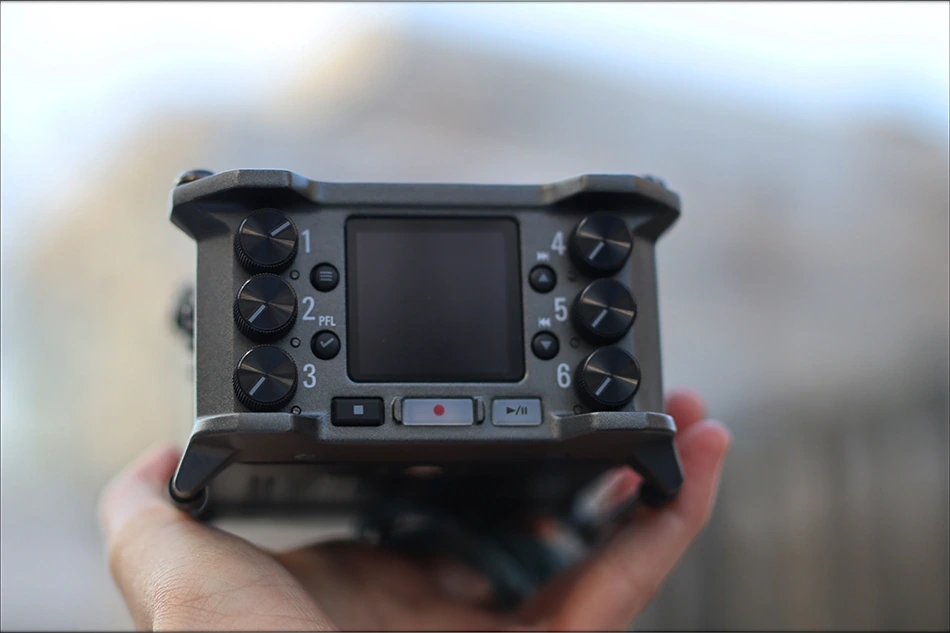
There are many recorders to choose from, but none so far hasn’t ever provided the level of clarity, precision and low levels of distortion that Zoom F6 is able to deliver, and I’m talking about larger mixers and such too. If you’re on the Go, and if you’re a filmmaker, if you want to make some awesome content, you’ll want to know that Zoom F6 is the thing to get.
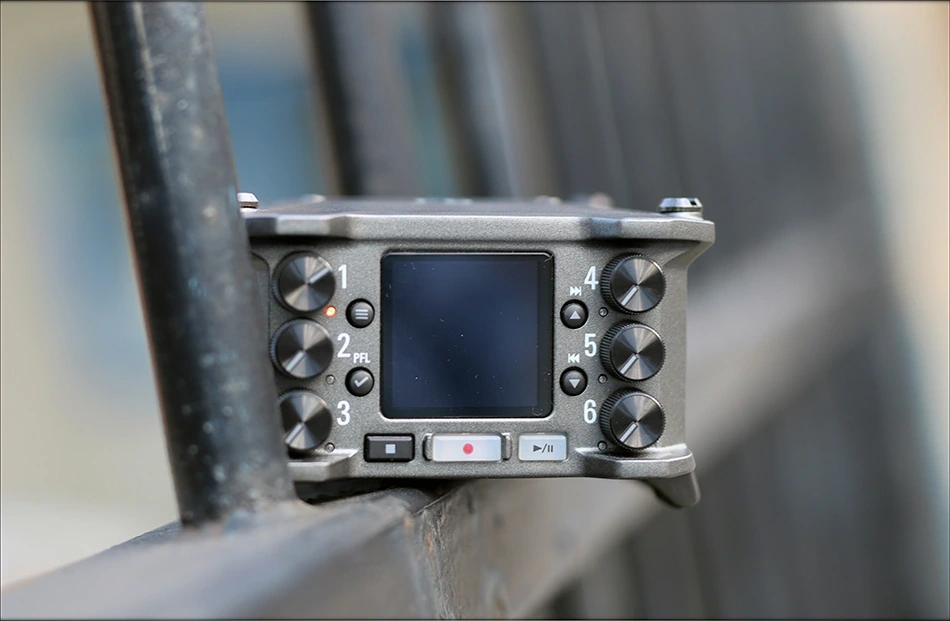
In fact, even big productions and big studios, including series from Disney and big movies, along with rock and metal bands are using Zoom interfaces and portable recorders. Most movies and series are filmed in conditions where you simply can’t bring a full sized interface connected to a power source, so portable recorders like Zoom F6 are perfect and just the thing to get to get that crisp, perfect audio. At the moment I’m writing this full written review, I just posted my video review on FiiO BTR5 2021, and because it had poor audio (it was not recorded with F6), it did not bring new subscribers, but videos on much more obscure products that have a good audio tend to bring new subscribers, so for Youtubing as well as artistic videos, audio is more than half the value of that video.
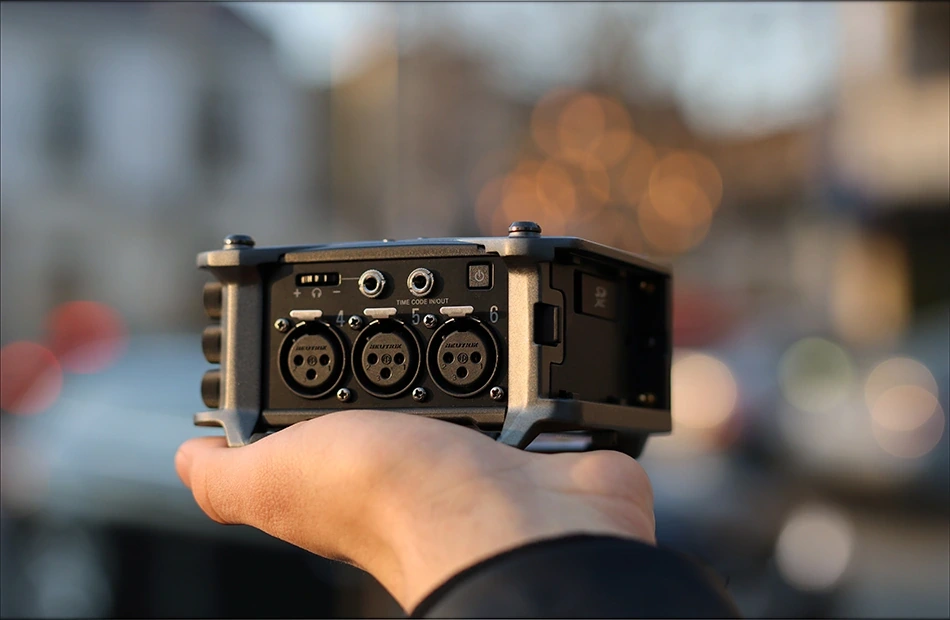
Before closing today’s full written review, I want to add Zoom F6 to Audiophile-Heaven’s Hall Of Fame as one of the most recommended interfaces, but not only. This is the kind of product that you can use for driving IEMS and Headphones too, and although it doesn’t have an ergonomic interface for headphones, it could be just the perfect tool for recording voice for a studio. Don’t forget, it works both as a soundcard interface, and can record to its own microSD card at the same time.
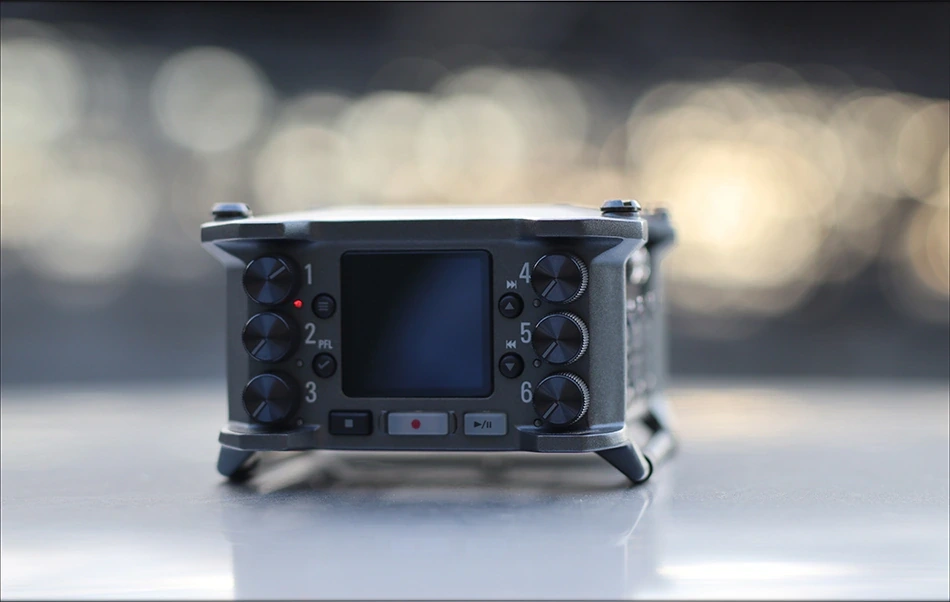
At the end of today’s review, zoom took me by surprise with their F6, and although I was not a strong believer in the quality of interfaces, F6 delivers really nicely, and delivers on everything it promises to deliver. It is an interface with a detailed, vivid, and clean sound, no distortions, and it is perfect for both novices, but also professional film makers, and game developers too.
Product Link
You can grab one from www.amazon.com here: https://amzn.to/3AJcVgS
If you’re in the UK, you can grab one from www.amazon.co.uk here: https://amzn.to/3GeKpVs
And if you’re from Europe, you can grab one from www.amazon.de here: https://amzn.to/3rduT7S
--- Please remember to stay safe, and always have fun while listening to music!---
- If you have a dime to spare, please donate, and help us! It would make the day brighter for me and my wife-
Full Playlist used for this review
We listened to more songs than those named in this playlist, but those are excellent for identifying a sonic signature. I recommend trying most of the songs from this playlist, especially if you’re searching for new music! The playlists are different for Spotify, Tidal and Youtube, and based on the songs I enjoy and are available on each!
https://www.youtube.com/playlist?list=PL_cjBXGmwSHSdGcwuc_bKbBDGHL4QvYBu
https://open.spotify.com/playlist/5J3oloz8Riy9LxEGenOjQ0?si=979ba4f082414be7
https://tidal.com/browse/playlist/330fd544-8e5b-4839-bd35-676b2edbb3d5
--- Contact Us ---






Super nice Review!
Super awesome review!
Super tight review, mate! Ordered one of those interfaces for my band, I hope it’ll work alright for our mini studio
Thanks a lo for the excellent review. You convinced me to order one for my new Youtube project!
Super excellent take! I ordered one following your review, and it is exactly what I was looking for!
Super nice review! F6 is now my daily recorder, and I used your Amazon link when ordering, hope you keep writing those excellent reviews!
Super nice review, with good photos and all the answers I was looking for! I ended up ordering one following your Amazon links!
Love your review, decided to grab one for my project after reading it! Thanks a lot for all your help!